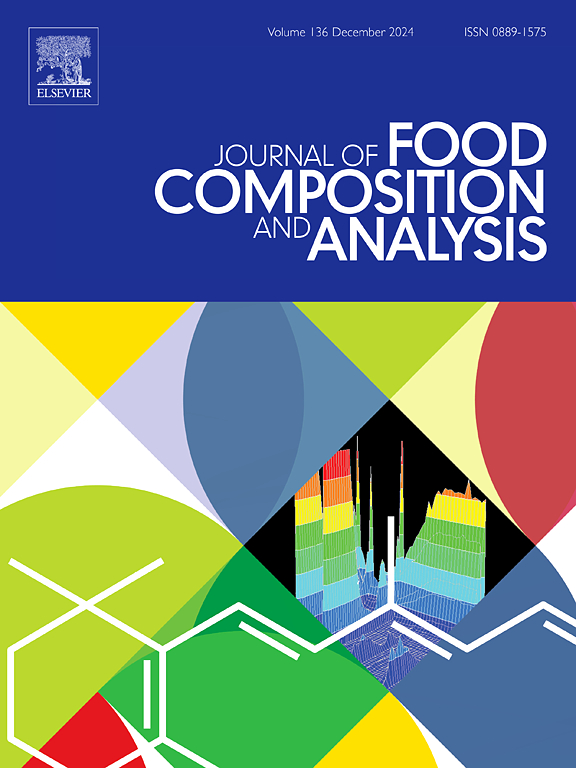Comparative analysis of morphological characteristics and nutritional quality in wild-caught and pond-reared female mud crab, Scylla paramamosain
IF 4.6
2区 农林科学
Q2 CHEMISTRY, APPLIED
引用次数: 0
Abstract
The mud crab Scylla paramamosain is an important species in marine aquaculture, valued for its high commercial price and consumer demand. Wild-caught individuals are often perceived as superior in taste and texture and thus command premium prices, while pond-reared crabs are more accessible and produced under controlled conditions. However, the nutritional quality differences between wild-caught and pond-reared individuals remain unclear, which poses challenges for market differentiation, consumer guidance, and aquaculture optimization. This study investigated the differences in nutritional quality between wild-caught and pond-reared female S. paramamosain, and further conducted morphometric analyses to determine whether they can be reliably distinguished. Morphometric analyses indicated significant differences in 12 of 18 measured parameters, with wild-caught crabs exhibiting relatively longer pereopods and swimming legs. Proximate composition analyses revealed minimal differences, except that pond-reared crabs had a significantly higher hepatosomatic index (HSI), while wild crabs exhibited higher muscle ash content. Pond-reared crabs possessed higher yellowness (b*) in carapace and ovary, higher redness (a*) and yellowness (b*) in hepatopancreas and muscle, and elevated total carotenoid levels across tissues. Fatty acid analyses indicated higher EPA but lower DHA levels in wild-caught crab ovaries and hepatopancreas, resulting in a significantly increased EPA/DHA ratio. Amino acid profiles showed no significant difference in total essential amino acids in ovaries and muscle between groups, with essential amino acid scores (EAAS) all exceeding 100. Overall, results suggest that pond-reared female S. paramamosain has higher dietary nutritional value and can be distinguished from wild-caught counterparts using morphometric analysis. These findings have practical implications for market differentiation and consumer guidance, supporting value-based pricing and informed dietary choices in the seafood industry.
野生和塘养雌泥蟹形态特征和营养品质的比较分析
Scylla paramamosain泥蟹(Scylla paramamosain)是海洋养殖中的重要品种,因其较高的商业价格和消费需求而受到重视。野生捕获的螃蟹通常被认为味道和质地都更好,因此价格更高,而池塘饲养的螃蟹更容易获得,并且在受控条件下生产。然而,野生捕捞和池塘养殖个体之间的营养品质差异尚不清楚,这给市场分化、消费者指导和水产养殖优化带来了挑战。本研究调查了野生捕获和池塘饲养的雌性paramamosain在营养品质上的差异,并进一步进行了形态计量学分析,以确定它们是否可以可靠地区分。形态计量学分析表明,18个测量参数中的12个存在显著差异,野生捕获的螃蟹表现出相对较长的准足类和游泳腿。近似成分分析显示,除了池养蟹的肝体指数(HSI)显著高于野生蟹的肌灰分含量外,其他差异很小。池塘饲养的螃蟹在甲壳和卵巢中具有较高的黄度(b*),在肝胰腺和肌肉中具有较高的红度(a*)和黄度(b*),并且在组织中具有较高的总类胡萝卜素水平。脂肪酸分析表明,野生蟹子房和肝胰腺中EPA含量较高,DHA含量较低,导致EPA/DHA比值显著升高。氨基酸谱显示,各组卵巢和肌肉必需氨基酸总量差异不显著,必需氨基酸评分(EAAS)均超过100。综上所述,池塘饲养的雌性paramamosain具有更高的膳食营养价值,并且可以通过形态计量学分析将其与野生捕获的同类区分开来。这些发现对市场分化和消费者指导具有实际意义,支持海鲜行业基于价值的定价和明智的饮食选择。
本文章由计算机程序翻译,如有差异,请以英文原文为准。
求助全文
约1分钟内获得全文
求助全文
来源期刊

Journal of Food Composition and Analysis
工程技术-食品科技
CiteScore
6.20
自引率
11.60%
发文量
601
审稿时长
53 days
期刊介绍:
The Journal of Food Composition and Analysis publishes manuscripts on scientific aspects of data on the chemical composition of human foods, with particular emphasis on actual data on composition of foods; analytical methods; studies on the manipulation, storage, distribution and use of food composition data; and studies on the statistics, use and distribution of such data and data systems. The Journal''s basis is nutrient composition, with increasing emphasis on bioactive non-nutrient and anti-nutrient components. Papers must provide sufficient description of the food samples, analytical methods, quality control procedures and statistical treatments of the data to permit the end users of the food composition data to evaluate the appropriateness of such data in their projects.
The Journal does not publish papers on: microbiological compounds; sensory quality; aromatics/volatiles in food and wine; essential oils; organoleptic characteristics of food; physical properties; or clinical papers and pharmacology-related papers.
 求助内容:
求助内容: 应助结果提醒方式:
应助结果提醒方式:


